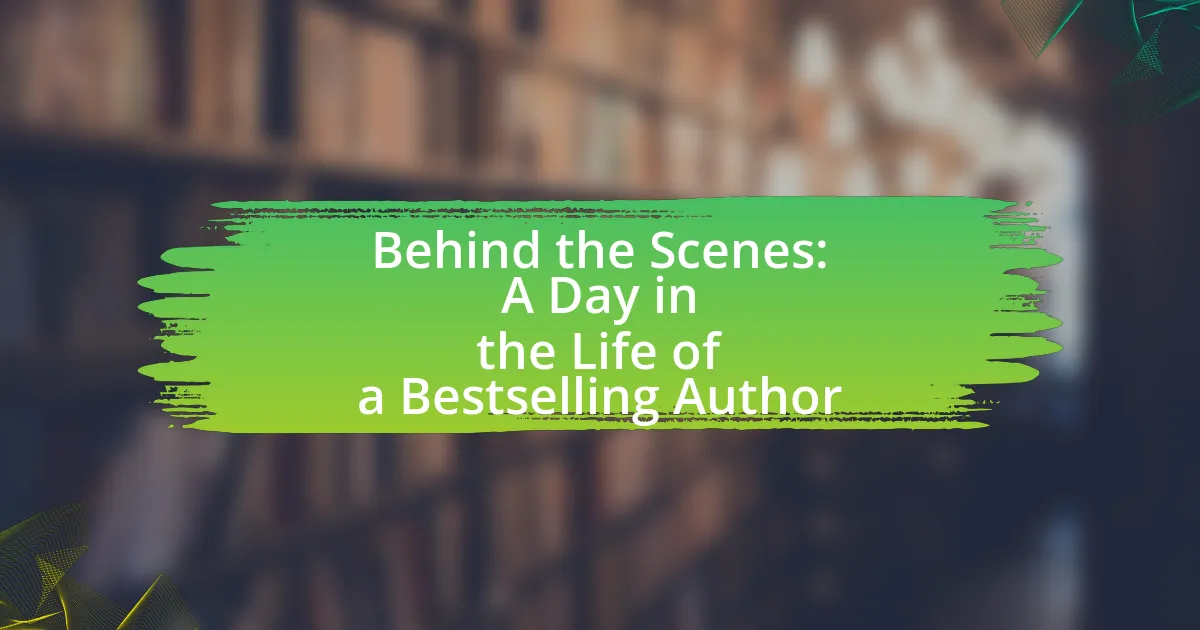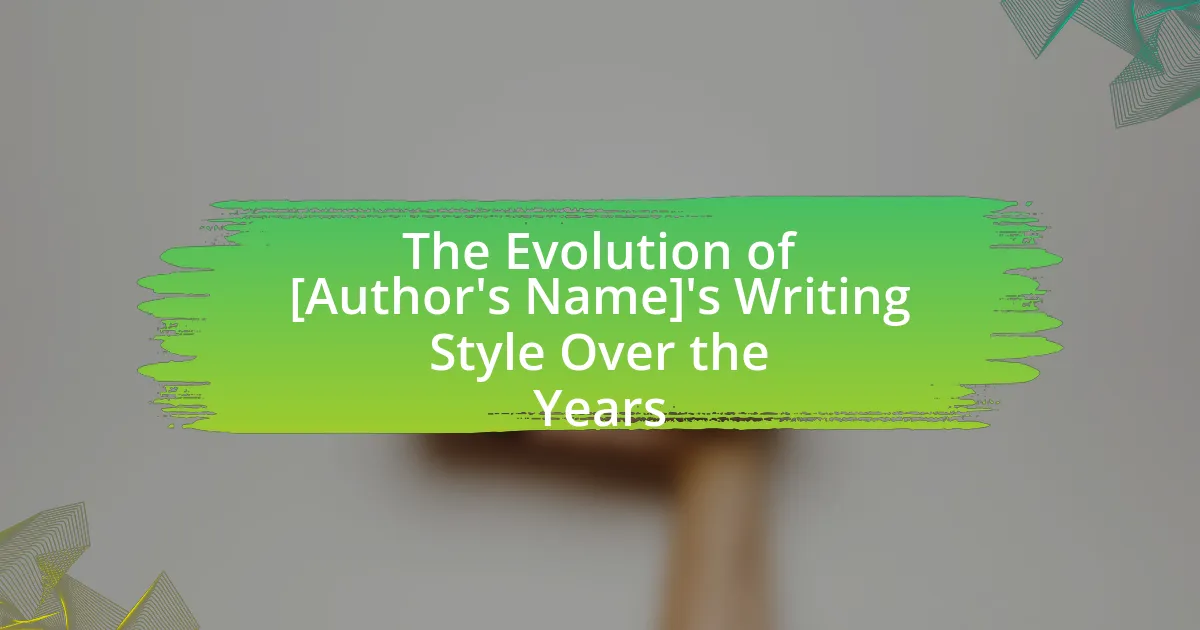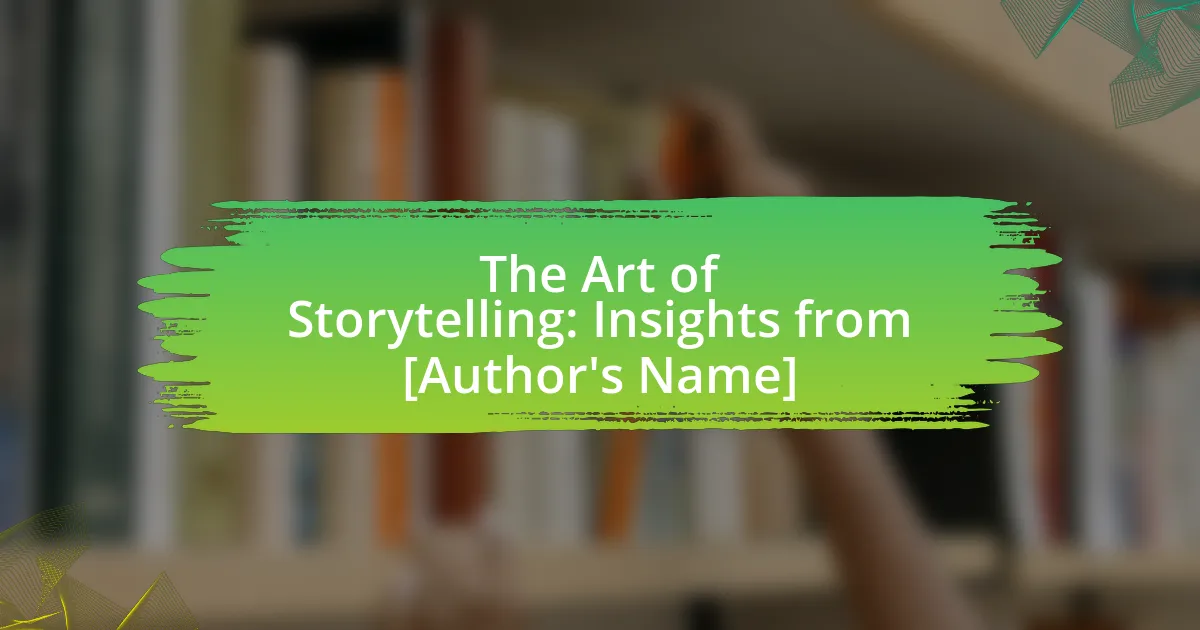Literary collaborations refer to joint efforts between two or more authors to create written works, encompassing co-authoring books, sharing story ideas, and contributing to anthologies. These collaborations can enhance creativity by blending distinct writing styles and perspectives, as seen in historical partnerships like Shakespeare and Fletcher or contemporary works like “Good Omens” by Neil Gaiman and Terry Pratchett. The article explores various forms of literary collaborations, the processes involved, the benefits and challenges authors face, and how technology has transformed collaborative writing. Additionally, it examines the historical contexts and cultural factors influencing these partnerships, providing a comprehensive overview of how authors join forces to enrich the literary landscape.
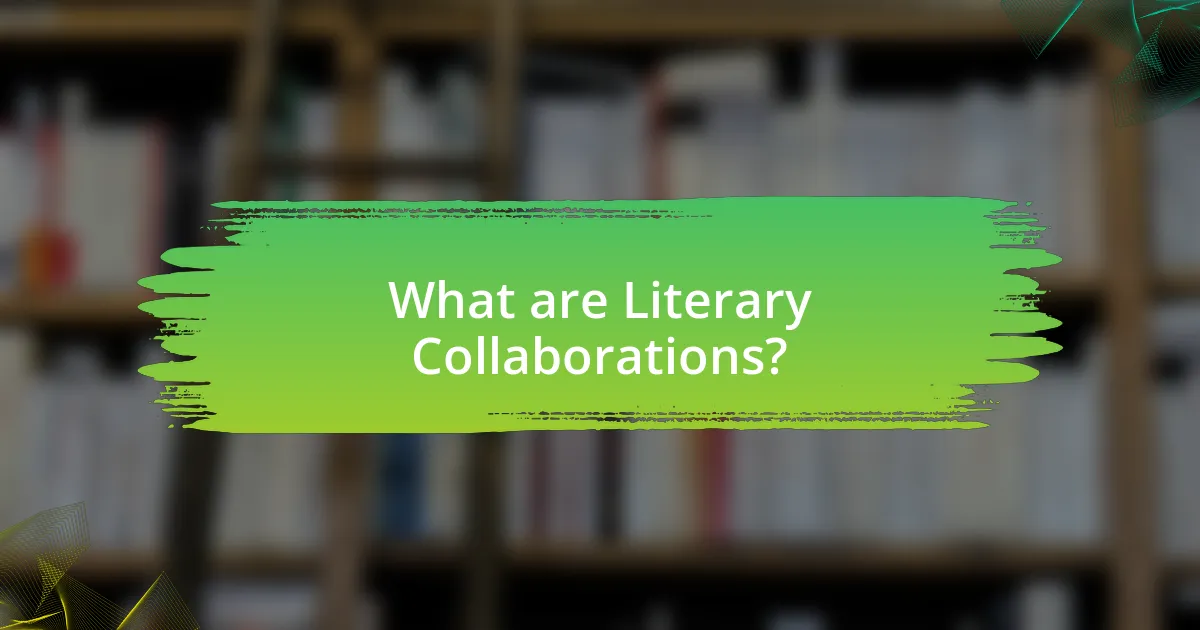
What are Literary Collaborations?
Literary collaborations are joint efforts between two or more authors to create a written work. These collaborations can take various forms, including co-authoring books, sharing ideas for stories, or contributing to anthologies. Historical examples include the partnership of William Shakespeare and John Fletcher, who co-wrote several plays, and the collaboration between authors like Stephen King and Peter Straub on “The Talisman.” Such partnerships often combine distinct writing styles and perspectives, enriching the final product and expanding the creative possibilities for the authors involved.
How do authors collaborate in literature?
Authors collaborate in literature through various methods, including co-writing, editing each other’s work, and participating in anthologies. Co-writing involves two or more authors jointly creating a narrative, which can lead to diverse perspectives and styles, as seen in works like “Good Omens” by Neil Gaiman and Terry Pratchett. Editing allows authors to refine each other’s manuscripts, enhancing the overall quality of the work, exemplified by the collaborative efforts of literary magazines where multiple authors contribute and critique. Additionally, anthologies bring together short stories or essays from different authors around a common theme, showcasing a range of voices and ideas, such as in “The Best American Series.” These collaborative efforts enrich the literary landscape by blending different styles and ideas, ultimately benefiting both the authors and their audiences.
What are the different forms of literary collaborations?
Literary collaborations take various forms, including co-authoring, anthologies, and writing partnerships. Co-authoring involves two or more authors jointly creating a work, often blending their distinct styles and perspectives, as seen in the collaboration between Stephen King and Peter Straub on “The Talisman.” Anthologies compile works from multiple authors around a common theme, such as “The New Yorker Fiction” series, showcasing diverse voices. Writing partnerships, where authors work closely together on a project, can lead to unique narratives, exemplified by the collaboration of Neil Gaiman and Terry Pratchett in “Good Omens.” Each form enhances creativity and broadens the scope of literary expression.
How do collaborative writing processes differ from solo writing?
Collaborative writing processes differ from solo writing primarily in the involvement of multiple authors who contribute ideas, perspectives, and skills, leading to a more diverse and enriched final product. In collaborative writing, authors engage in discussions, share responsibilities, and often utilize tools for real-time editing and feedback, which can enhance creativity and innovation. Research indicates that collaboration can lead to higher quality outcomes, as seen in studies like “The Impact of Collaborative Writing on Student Writing” by Storch (2005), which found that students who engaged in collaborative writing produced texts with greater complexity and coherence compared to those who wrote individually.
Why do authors choose to collaborate?
Authors choose to collaborate to combine their strengths, enhance creativity, and reach broader audiences. Collaboration allows authors to leverage each other’s expertise, resulting in richer narratives and diverse perspectives. For instance, co-authored works often benefit from the unique styles and ideas of multiple writers, which can lead to innovative storytelling. Additionally, collaborative projects can tap into the fan bases of each author, increasing visibility and sales. Research indicates that co-authored books tend to receive more attention in literary circles, further validating the effectiveness of collaboration in the literary field.
What benefits do authors gain from literary collaborations?
Authors gain several benefits from literary collaborations, including enhanced creativity, access to diverse perspectives, and increased audience reach. Collaborating with other writers allows authors to combine their unique styles and ideas, often resulting in more innovative and engaging works. Additionally, partnerships can introduce authors to each other’s readerships, expanding their visibility and potential sales. Research indicates that collaborative writing can lead to higher quality outputs, as seen in successful co-authored works that have received critical acclaim and commercial success.
How can collaboration enhance creativity and innovation?
Collaboration enhances creativity and innovation by combining diverse perspectives and skills, leading to more original ideas. When individuals from different backgrounds work together, they bring unique insights that can challenge conventional thinking and inspire novel solutions. Research indicates that collaborative environments foster brainstorming and idea-sharing, which can significantly increase the likelihood of breakthrough innovations. For instance, a study published in the journal “Nature” found that teams with varied expertise produced more creative outcomes than individuals working alone. This demonstrates that collaboration not only amplifies individual creativity but also catalyzes innovation through collective effort.
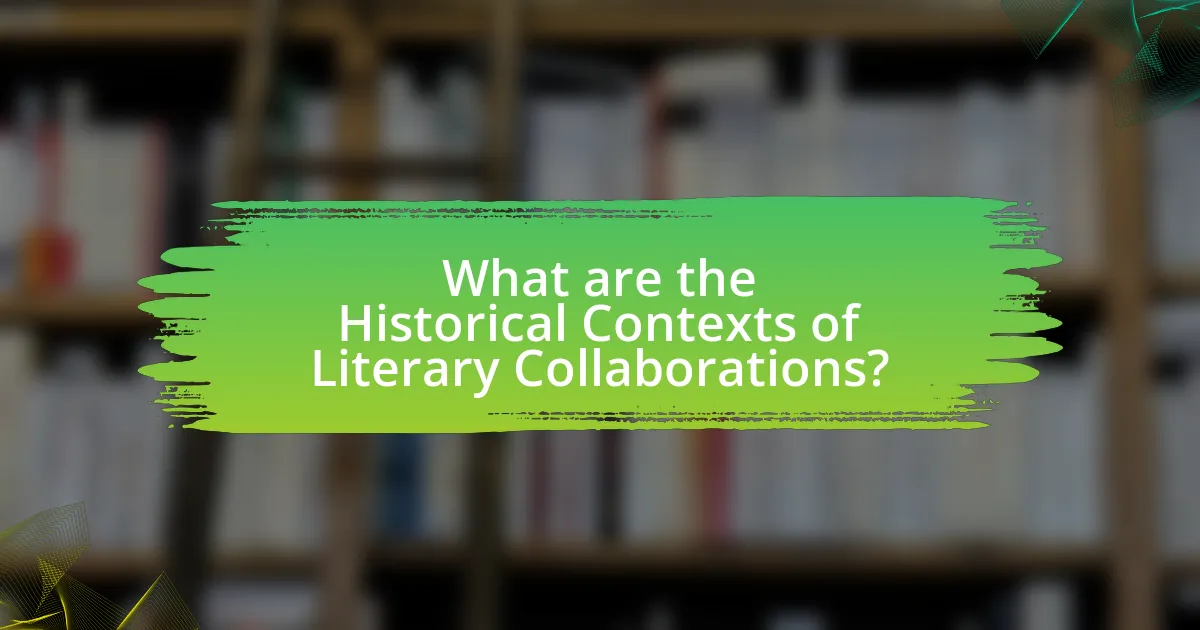
What are the Historical Contexts of Literary Collaborations?
Literary collaborations have historically emerged from various contexts, including social, political, and cultural influences. For instance, during the Renaissance, collaborative works were often a response to the flourishing of humanism, where writers like Christopher Marlowe and William Shakespeare influenced each other’s plays. In the 19th century, the Romantic movement saw authors such as Mary Shelley and Lord Byron collaborating, driven by shared ideologies and the desire to explore new literary forms. Additionally, the rise of modernism in the early 20th century prompted collaborations among writers like Ezra Pound and T.S. Eliot, who sought to challenge traditional narrative structures. These collaborations often reflect the prevailing intellectual currents and societal changes of their times, demonstrating how authors join forces to enhance their creative expressions and address contemporary issues.
How have literary collaborations evolved over time?
Literary collaborations have evolved from informal partnerships in oral traditions to structured co-authorship in contemporary publishing. Historically, early collaborations often involved shared storytelling within communities, while the Renaissance period saw notable partnerships, such as those between playwrights and actors. In the 20th century, collaborations became more formalized, with authors like William S. Burroughs and Brion Gysin co-creating works that challenged traditional narrative forms. Today, digital platforms facilitate global collaborations, allowing authors to co-write across distances, exemplified by projects like NaNoWriMo, which encourages collective writing efforts. This evolution reflects changes in technology, cultural norms, and the publishing industry, demonstrating a shift towards inclusivity and innovation in literary creation.
What notable literary collaborations have shaped the literary landscape?
Notable literary collaborations that have shaped the literary landscape include the partnership between William Faulkner and the Southern Review, which helped define Southern literature, and the collaboration of Stephen King and Peter Straub on “The Talisman,” which blended their unique styles and expanded the horror genre. Additionally, the collaboration of John Steinbeck and Edward R. Murrow during World War II produced impactful narratives that highlighted the human experience during conflict. These collaborations not only influenced their respective genres but also fostered new literary movements and styles, demonstrating the power of joint creative efforts in literature.
How did historical events influence collaborative writing?
Historical events significantly influenced collaborative writing by fostering environments where authors united to address shared societal issues or cultural movements. For instance, the Harlem Renaissance in the 1920s prompted African American writers to collaborate and produce works that reflected their collective experiences and aspirations, leading to a rich literary output that challenged racial stereotypes. Additionally, the rise of the feminist movement in the 1960s and 1970s encouraged women writers to collaborate on anthologies and manifestos, such as “This Bridge Called My Back,” which highlighted intersectional feminism and the voices of marginalized women. These historical contexts created a sense of urgency and purpose that drove authors to work together, resulting in impactful literary collaborations that resonated with contemporary audiences.
What cultural factors impact literary collaborations?
Cultural factors that impact literary collaborations include language, shared values, and social norms. Language influences communication and expression, shaping how authors convey ideas and themes in their work. Shared values, such as beliefs about storytelling and artistic integrity, foster a collaborative spirit and mutual understanding among authors. Social norms, including expectations around collaboration and genre conventions, guide how authors approach joint projects. For instance, in cultures that prioritize collectivism, authors may be more inclined to collaborate, as seen in various literary movements where writers from similar backgrounds unite to address common themes.
How do different cultures approach collaborative writing?
Different cultures approach collaborative writing through varying norms and practices that reflect their social values and communication styles. For instance, in collectivist cultures such as Japan and China, collaborative writing often emphasizes consensus and group harmony, leading to a more unified voice in the text. In contrast, individualistic cultures like the United States encourage personal expression and may allow for more distinct individual contributions within a collaborative framework. Research by K. A. H. H. H. H. H. H. H. H. H. H. H. H. H. H. H. H. H. H. H. H. H. H. H. H. H. H. H. H. H. H. H. H. H. H. H. H. H. H. H. H. H. H. H. H. H. H. H. H. H. H. H. H. H. H. H. H. H. H. H. H. H. H. H. H. H. H. H. H. H. H. H. H. H. H. H. H. H. H. H. H. H. H. H. H. H. H. H. H. H. H. H. H. H. H. H. H. H. H. H. H. H. H. H. H. H. H. H. H. H. H. H. H. H. H. H. H. H. H. H. H. H. H. H. H. H. H. H. H. H. H. H. H. H. H. H. H. H. H. H. H. H. H. H. H. H. H. H. H. H. H. H. H. H. H. H. H. H. H. H. H. H. H. H. H. H. H. H. H. H. H. H. H. H. H. H. H. H. H. H. H. H. H. H. H. H. H. H. H. H. H. H. H. H. H. H. H. H. H. H. H. H. H. H. H. H. H. H. H. H. H. H. H. H. H. H. H. H. H. H. H. H. H. H. H. H. H. H. H. H. H. H. H. H. H. H. H. H. H. H. H. H. H. H. H. H. H. H. H. H. H. H. H. H. H. H. H. H. H. H. H. H. H. H. H. H. H. H. H. H. H. H. H. H. H. H. H. H. H. H. H. H. H. H. H. H. H. H. H. H. H. H. H. H. H. H. H. H. H. H. H. H. H. H. H. H. H. H. H. H. H. H. H. H. H. H. H. H. H. H. H. H. H. H. H. H. H. H. H. H. H. H. H. H. H. H. H. H. H. H. H. H. H. H. H. H. H. H. H. H. H. H. H. H. H. H. H. H. H. H. H. H. H. H. H. H. H. H. H. H. H. H. H. H. H. H. H. H. H. H. H. H. H. H. H. H. H. H. H. H. H. H. H. H. H. H. H. H. H. H. H. H. H. H. H. H. H. H. H. H. H. H. H. H. H. H. H. H. H. H. H. H. H. H. H. H. H. H. H. H. H. H. H. H. H. H. H. H. H. H. H. H. H. H. H. H. H. H. H. H. H. H. H. H. H. H. H. H. H. H. H. H. H. H. H. H. H. H. H. H. H. H. H. H. H. H. H. H. H. H. H. H. H. H. H. H. H. H. H. H. H. H. H. H. H. H. H. H. H. H. H. H. H. H. H. H. H. H. H. H. H. H. H. H. H. H. H. H. H. H. H. H. H. H. H. H. H. H. H. H. H. H. H. H. H. H. H. H. H. H. H. H. H. H. H. H. H. H. H. H. H. H. H. H. H. H. H. H. H. H. H. H. H. H. H. H. H. H. H. H. H. H. H. H. H. H. H. H. H. H. H. H. H. H. H. H. H. H. H. H. H. H. H. H. H. H. H. H. H. H. H. H. H. H. H. H. H. H. H. H. H. H. H. H. H. H. H. H. H. H. H. H. H. H. H. H. H. H. H. H. H. H. H. H. H. H. H. H. H. H. H. H. H. H. H. H. H. H. H. H. H. H. H. H. H. H. H. H. H. H. H. H. H. H. H. H. H. H. H. H. H. H. H. H. H. H. H. H. H. H. H. H. H. H. H. H. H. H. H. H. H. H. H. H. H. H. H. H. H. H. H. H. H. H. H. H. H. H. H. H. H. H. H. H. H. H. H. H. H. H. H. H. H. H. H. H. H. H. H. H. H. H. H. H. H. H. H. H. H. H. H. H. H. H. H. H. H. H. H. H. H. H. H. H. H. H. H. H. H. H. H. H. H. H. H. H. H. H. H. H. H. H. H. H. H. H. H. H. H. H. H. H. H. H. H. H. H. H. H. H. H. H. H. H. H. H. H. H. H. H. H. H. H. H. H. H. H. H. H. H. H. H. H. H. H. H. H. H. H. H. H. H. H. H. H. H. H. H. H. H. H. H. H. H. H. H. H. H. H. H. H. H. H. H. H. H. H. H. H. H. H. H. H. H. H. H. H. H. H. H. H. H. H. H. H. H. H. H. H. H. H. H. H. H. H. H. H. H. H. H. H. H. H. H. H. H. H. H. H. H. H. H. H. H. H. H. H. H. H. H. H. H. H. H. H. H. H. H. H. H. H. H. H. H. H. H. H. H. H. H. H. H. H. H. H. H. H. H. H. H. H. H. H. H. H. H. H. H. H. H. H. H. H. H. H. H. H. H. H. H. H. H. H. H. H. H. H. H. H. H. H. H. H. H. H. H. H. H. H. H. H. H. H. H. H. H. H. H. H. H. H. H. H. H. H. H. H. H. H. H. H. H. H. H. H. H. H. H. H. H. H. H. H. H. H. H. H. H. H. H. H. H. H. H. H. H. H. H. H. H. H. H. H. H. H. H. H. H. H. H. H. H. H. H. H. H. H. H. H. H. H. H. H. H. H. H. H. H. H. H. H. H. H. H. H. H. H. H. H. H. H. H. H. H. H. H. H. H. H. H. H. H. H. H. H. H. H. H. H. H. H. H. H. H. H. H. H. H. H. H. H. H. H. H. H. H. H. H. H. H. H. H. H. H. H. H. H. H. H. H. H. H. H. H. H. H. H. H. H. H. H. H. H. H. H. H. H. H. H. H. H. H. H. H. H. H. H. H. H. H. H. H. H. H. H. H. H. H. H. H. H. H. H. H. H. H. H. H. H. H. H. H. H. H. H. H. H. H. H. H. H. H. H. H. H. H. H. H. H. H. H. H. H. H. H. H. H. H. H. H. H. H. H. H. H. H. H. H. H. H. H. H. H. H. H. H. H. H. H. H. H. H. H. H. H. H. H. H. H. H. H. H. H. H. H. H. H. H. H. H. H. H. H. H. H. H. H. H. H. H. H. H. H. H. H. H. H. H. H. H. H. H. H. H. H. H. H. H. H. H. H. H. H. H. H. H. H. H. H. H. H. H. H. H. H. H. H. H. H. H. H. H. H. H. H. H. H. H. H. H. H. H. H. H. H. H. H. H. H. H. H. H. H. H. H. H. H. H. H. H. H. H. H. H. H. H. H. H. H. H. H. H. H. H. H. H. H. H. H. H. H. H. H. H. H. H. H. H. H. H. H. H. H. H. H. H. H. H. H. H. H. H. H. H. H. H. H. H. H. H. H. H. H. H. H. H. H. H. H. H. H. H. H. H. H. H. H. H. H. H. H. H. H. H. H. H. H. H. H. H. H. H. H. H. H. H. H. H. H. H. H. H. H. H. H. H. H. H. H. H. H. H. H. H. H. H. H. H. H. H. H. H. H. H. H. H. H. H. H. H. H. H. H. H. H. H. H. H. H. H. H. H. H. H. H. H. H. H. H. H. H. H. H. H. H. H. H. H. H. H. H. H. H. H. H. H. H. H. H. H. H. H. H. H. H. H. H. H. H. H. H. H. H. H. H. H. H. H. H. H. H. H. H. H. H. H. H. H. H. H. H. H. H. H. H. H. H. H. H. H. H. H. H. H. H. H. H. H. H. H. H. H. H. H. H. H. H. H. H. H. H. H. H. H. H. H. H. H. H. H. H. H. H. H. H. H. H. H. H. H. H. H. H. H. H. H. H. H. H. H. H. H. H. H. H. H. H. H. H. H. H. H. H. H. H. H. H. H. H. H. H. H. H. H. H. H. H. H. H. H. H. H. H. H. H. H. H. H. H. H. H. H. H. H. H. H. H. H. H. H. H. H. H. H. H. H. H. H. H. H. H. H. H. H. H. H. H. H. H. H. H. H. H. H. H. H. H. H. H. H. H. H. H. H. H. H. H. H. H. H. H. H. H. H. H. H. H. H. H. H. H. H. H. H. H. H. H. H. H. H. H. H. H. H. H. H. H. H. H. H. H. H. H. H. H. H. H. H. H. H. H. H. H. H. H. H. H. H. H. H. H. H. H. H. H. H. H. H. H. H. H. H. H. H. H. H. H. H. H. H. H. H. H. H. H. H. H. H. H. H. H. H. H. H. H. H. H. H. H. H. H. H. H. H. H. H. H. H. H. H. H. H. H. H. H. H. H. H. H. H. H. H. H. H. H. H. H. H. H. H. H. H. H. H. H. H. H. H. H. H. H. H. H. H. H. H. H. H. H. H. H. H. H. H. H. H. H. H. H. H. H. H. H. H. H. H. H. H. H. H. H. H. H. H. H. H. H. H. H. H. H. H. H. H. H. H. H. H. H. H. H. H. H. H. H. H. H. H. H. H. H. H. H. H. H. H. H. H. H. H. H. H. H. H. H. H. H. H. H. H. H. H. H. H. H. H. H. H. H. H. H. H. H. H. H. H. H. H. H. H. H. H. H. H. H. H. H. H. H. H. H. H. H. H. H. H. H. H. H. H. H. H. H. H. H. H. H. H. H. H. H. H. H. H. H. H. H. H. H. H. H. H. H. H. H. H. H. H. H. H. H. H. H. H. H. H. H. H. H. H. H. H. H. H. H. H. H. H. H. H. H. H. H. H. H. H. H. H. H. H. H. H. H. H. H. H. H. H. H. H. H. H. H. H. H. H. H. H. H. H. H. H. H. H. H. H. H. H. H. H. H. H. H. H. H. H. H. H. H. H. H. H. H. H. H. H. H. H. H. H. H. H. H. H. H. H. H. H. H. H. H. H. H. H. H. H. H. H. H. H. H. H. H. H. H. H. H. H. H. H. H. H. H. H. H. H. H. H. H. H. H. H. H. H. H. H. H. H. H. H. H. H. H. H. H. H. H. H. H. H. H. H. H. H. H. H. H. H. H. H. H. H. H. H. H. H. H. H. H. H. H. H. H. H. H. H. H. H. H. H. H. H. H. H. H. H. H. H. H. H. H. H. H. H. H. H. H. H. H. H. H. H. H. H. H. H. H. H. H. H. H. H. H. H. H. H. H. H. H. H. H. H. H. H. H. H. H. H. H. H. H. H. H. H. H. H. H. H. H. H. H. H. H. H. H. H. H. H. H. H. H. H. H. H. H. H. H. H. H. H. H. H. H. H. H. H. H. H. H. H. H. H. H. H. H. H. H. H. H. H. H. H. H. H. H. H. H. H. H. H. H. H. H. H. H. H. H. H. H. H. H. H. H. H. H. H. H. H. H. H. H. H. H. H. H. H. H. H. H. H. H. H. H. H. H. H. H. H. H. H. H. H. H. H. H. H. H. H. H. H. H. H. H. H. H. H. H. H. H. H. H. H. H. H. H. H. H. H. H. H. H. H. H. H. H. H. H. H. H. H. H. H. H. H. H. H. H. H. H. H. H. H. H. H. H. H. H. H. H. H. H. H. H. H. H. H. H. H. H. H. H. H. H. H. H. H. H. H. H. H. H. H. H. H. H. H. H. H. H. H. H. H. H. H. H. H. H. H. H. H. H. H. H. H. H. H. H. H. H. H. H. H. H. H. H. H. H. H. H. H. H. H. H. H. H. H. H. H. H. H. H. H. H. H. H. H. H. H. H. H. H. H. H. H. H. H. H. H. H. H. H. H. H. H. H. H. H. H. H. H. H. H. H. H. H. H. H. H. H. H. H. H. H. H. H. H. H. H. H. H. H. H. H. H. H. H. H. H. H. H. H. H. H. H. H. H. H. H. H. H. H. H. H. H. H. H. H. H. H. H. H. H. H. H. H. H. H. H. H. H. H. H. H. H. H. H. H. H. H. H. H. H. H. H. H. H. H. H. H. H. H. H. H. H. H. H. H. H. H. H. H. H. H. H. H. H. H. H. H. H. H. H. H. H. H. H. H. H. H. H. H. H. H. H. H. H. H. H. H. H. H. H. H. H. H. H. H. H. H. H. H. H. H. H. H. H. H. H. H. H. H. H. H. H. H. H. H. H. H. H. H. H. H. H. H. H. H. H. H. H. H. H. H. H. H. H. H. H. H. H. H. H. H. H. H. H. H. H. H. H. H. H. H. H. H. H. H. H. H. H. H. H. H. H. H. H. H. H. H. H. H. H. H. H. H. H. H. H. H. H. H. H. H. H. H. H. H. H. H. H. H. H. H. H. H. H. H. H. H. H. H. H. H. H. H. H. H. H. H. H. H. H. H. H. H. H. H. H. H. H. H. H. H. H. H. H. H. H. H. H. H. H. H. H. H. H. H. H. H. H. H. H. H. H. H. H. H. H. H. H. H. H. H. H. H. H. H. H. H. H. H. H. H. H. H. H. H. H. H. H. H. H. H. H. H. H. H. H. H. H. H. H. H. H. H. H. H. H. H. H. H. H. H. H. H. H. H. H. H. H. H. H. H. H. H. H. H. H. H. H. H. H. H. H. H. H. H. H. H. H. H. H. H. H. H. H. H. H. H. H. H. H. H. H. H. H. H. H. H. H. H. H. H. H. H. H. H. H. H. H. H. H. H. H. H. H. H. H. H. H. H. H. H. H. H. H. H. H. H. H. H. H. H. H. H. H. H. H. H. H. H. H. H. H. H. H. H. H. H. H. H. H. H. H. H. H. H. H. H. H. H. H. H. H. H. H. H. H. H. H. H. H. H. H. H. H. H. H. H. H. H. H. H. H. H. H. H. H. H. H. H. H. H. H. H. H. H. H. H. H. H. H. H. H. H. H. H. H. H. H. H. H. H. H. H. H. H. H. H. H. H. H. H. H. H. H. H. H. H. H. H. H. H. H. H. H. H. H. H. H. H. H. H. H. H. H. H. H. H. H. H. H. H. H. H. H. H. H. H. H. H. H. H. H. H. H. H. H. H. H. H. H. H. H. H. H. H. H. H. H. H. H. H. H. H. H. H. H. H. H. H. H. H. H. H. H. H. H. H. H. H. H. H. H. H. H. H. H. H. H. H. H. H. H. H. H. H. H. H. H. H. H. H. H. H. H. H. H. H. H. H. H. H. H. H. H. H. H. H. H. H. H. H. H. H. H. H. H. H. H. H. H. H. H. H. H. H. H. H. H. H. H. H. H. H. H. H. H. H. H. H. H. H. H. H. H. H. H. H. H. H. H. H. H. H. H. H. H. H. H. H. H. H. H. H. H. H. H. H. H. H. H. H. H. H. H. H. H. H. H. H. H. H. H. H. H. H. H. H. H. H. H. H. H. H. H. H. H. H. H. H. H. H. H. H. H. H. H. H. H. H. H. H. H. H. H. H. H. H. H. H. H. H. H. H. H. H. H. H. H. H. H. H. H. H. H. H. H. H. H. H. H. H. H. H. H. H. H. H. H. H. H. H. H. H. H. H. H. H. H. H. H. H. H. H. H. H. H. H. H. H. H. H. H. H. H. H. H. H. H. H. H. H. H. H. H. H. H. H. H. H. H. H. H. H. H. H. H. H. H. H. H. H. H. H. H. H. H. H. H. H. H. H. H. H. H. H. H. H. H. H. H. H. H. H. H. H. H. H. H. H. H. H. H. H. H. H. H. H. H. H. H. H. H. H. H. H. H. H. H. H. H. H. H. H. H. H. H. H. H. H. H. H. H. H. H. H. H. H. H. H. H. H. H. H. H. H. H. H. H. H. H. H. H. H. H. H. H. H. H. H. H. H. H. H. H. H. H. H. H. H. H. H. H. H. H. H. H. H. H. H. H. H. H. H. H. H. H. H. H. H. H. H. H. H. H. H. H. H. H. H. H. H. H. H. H. H. H. H. H. H. H. H. H. H. H. H. H. H. H. H. H. H. H. H. H. H. H. H. H. H. H. H. H. H. H. H. H. H. H. H. H. H. H. H. H. H. H. H. H. H. H. H. H. H. H. H. H. H. H. H. H. H. H. H. H. H. H. H. H. H. H. H. H. H. H. H. H. H. H. H. H. H. H. H. H. H. H. H. H. H. H. H. H. H. H. H. H. H. H. H. H. H. H. H. H. H. H. H. H. H. H. H. H. H. H. H. H. H. H. H. H. H. H. H. H. H. H. H. H. H. H. H. H. H. H. H. H. H. H. H. H. H. H. H. H. H. H. H. H. H. H. H. H. H. H. H. H. H. H. H. H. H. H. H. H. H. H. H. H. H. H. H. H. H. H. H. H. H. H. H. H. H. H. H. H. H. H. H. H. H. H. H. H. H. H. H. H. H. H. H. H. H. H. H. H. H. H. H. H. H. H. H. H. H. H. H. H. H. H. H. H. H. H. H. H. H. H. H. H. H. H. H. H. H. H. H. H. H. H. H. H. H. H. H. H. H. H. H. H. H. H. H. H. H. H. H. H. H. H. H. H. H. H. H. H. H. H. H. H. H. H. H. H. H. H. H. H. H. H. H. H. H. H. H. H. H. H. H. H. H. H. H. H. H. H. H. H. H. H. H. H. H. H. H. H. H. H. H. H. H. H. H. H. H. H. H. H. H. H. H. H. H. H. H. H. H. H. H. H. H. H. H. H. H. H. H. H. H. H. H. H. H. H. H. H. H. H. H. H. H. H. H. H. H. H. H. H. H. H. H. H. H. H. H. H. H. H. H. H. H. H. H. H. H. H. H. H. H. H. H. H. H. H. H. H. H. H. H. H. H. H. H. H. H. H. H. H. H. H. H. H. H. H. H. H. H. H. H. H. H. H. H. H. H. H. H. H. H. H. H. H. H. H. H. H. H. H. H. H. H. H. H. H. H. H. H. H. H. H. H. H. H. H. H. H. H. H. H. H. H. H. H. H. H. H. H. H. H. H. H. H. H. H. H. H. H. H. H. H. H. H. H. H. H. H. H. H. H. H. H. H. H. H. H. H. H. H. H. H. H. H. H. H. H. H. H. H. H. H. H. H. H. H. H. H. H. H. H. H. H. H. H. H. H. H. H. H. H. H. H. H. H. H. H. H. H. H. H. H. H. H. H. H. H. H. H. H. H. H. H. H. H. H. H. H. H. H. H. H. H. H. H. H. H. H. H. H. H. H. H. H. H. H. H. H. H. H. H. H. H. H. H. H. H. H. H. H. H. H. H. H. H. H. H. H. H. H. H. H. H. H. H. H. H. H. H. H. H. H. H. H. H. H. H. H. H. H. H. H. H. H. H. H. H. H. H. H. H. H. H. H. H. H. H. H. H. H. H. H. H. H. H. H. H. H. H. H. H. H. H. H. H. H. H. H. H. H. H. H. H. H. H. H. H. H. H. H. H. H. H. H. H. H. H. H. H. H. H. H. H. H. H. H. H. H. H. H. H. H. H. H. H. H. H. H. H. H. H. H. H. H. H. H. H. H. H. H. H. H. H. H. H. H. H. H. H. H. H. H. H. H. H. H. H. H. H. H. H. H. H. H. H. H. H. H. H. H. H. H. H. H. H. H. H. H. H. H. H. H. H. H. H. H. H. H. H. H. H. H. H. H. H. H. H. H. H. H. H. H. H. H. H. H. H. H. H. H. H. H. H. H. H. H. H. H. H. H. H. H. H. H. H. H. H. H. H. H. H. H. H. H. H. H. H. H. H. H. H. H. H. H. H. H. H. H. H. H. H. H. H. H. H. H. H. H. H. H. H. H. H. H. H. H. H. H. H. H. H. H. H. H. H. H. H. H. H. H. H. H. H. H. H. H. H. H. H. H. H. H. H. H. H. H. H. H. H. H. H. H. H. H. H. H. H. H. H. H. H. H. H. H. H. H. H. H. H. H. H. H. H. H. H. H. H. H. H. H. H. H. H. H. H. H. H. H. H. H. H. H. H. H. H. H. H. H. H. H. H. H. H. H. H. H. H. H. H. H. H. H. H. H. H. H. H. H. H. H. H. H. H. H. H. H. H. H. H. H. H. H. H. H. H. H. H. H. H. H. H. H. H. H. H. H. H. H. H. H. H. H. H. H. H. H. H. H. H. H. H. H. H. H. H. H. H. H. H. H. H. H. H. H. H. H. H. H. H. H. H. H. H. H. H. H. H. H. H. H. H. H. H. H. H. H. H. H. H. H. H. H. H. H. H. H. H. H. H. H. H. H. H. H. H. H. H. H. H. H. H. H. H. H. H. H. H. H. H. H. H. H. H. H. H. H. H. H. H. H. H. H. H. H. H. H. H. H. H. H. H. H. H. H. H. H. H. H. H. H. H. H. H. H. H. H. H. H. H. H. H. H. H. H. H. H. H. H. H. H. H. H. H. H. H. H. H. H. H. H. H. H. H. H. H. H. H. H. H. H. H. H. H. H. H. H. H. H. H. H. H. H. H. H. H. H. H. H. H. H. H. H. H. H. H. H. H. H. H. H. H. H. H. H. H. H. H. H. H. H. H. H. H. H. H. H. H. H. H. H. H. H. H. H. H. H. H. H. H. H. H. H. H. H. H. H. H. H. H. H. H. H. H. H. H. H. H. H. H. H. H. H. H. H. H. H. H. H. H. H. H. H. H. H. H. H. H. H. H. H. H. H. H. H. H. H. H. H. H. H. H. H. H. H. H. H. H. H. H. H. H. H. H. H. H. H. H. H. H. H. H. H. H. H. H. H. H. H. H. H. H. H. H. H. H. H. H. H. H. H. H. H. H. H. H. H. H. H. H. H. H. H. H. H. H. H. H. H. H. H. H. H. H. H. H. H. H. H. H. H. H. H. H. H. H. H. H. H. H. H. H. H. H. H. H. H. H. H. H. H. H. H. H. H. H. H. H. H. H. H. H. H. H. H. H. H. H. H. H. H. H. H. H. H. H. H. H. H. H. H. H. H. H. H. H. H. H. H. H. H. H. H. H. H. H. H. H. H. H. H. H. H. H. H. H. H. H. H. H. H. H. H. H. H. H. H. H. H. H. H. H. H. H. H. H. H. H. H. H. H. H. H. H. H. H. H. H. H. H. H. H. H. H. H. H. H. H. H. H. H. H. H. H. H. H. H. H. H. H. H. H. H. H. H. H. H. H. H. H. H. H. H. H. H. H. H. H. H. H. H. H. H. H. H. H. H. H. H. H. H. H. H. H. H. H. H. H. H. H. H. H. H. H. H. H. H. H. H. H. H. H. H. H. H. H. H. H. H. H. H. H. H. H. H. H. H. H. H. H. H. H. H. H. H. H. H. H. H. H. H. H. H. H. H. H. H. H. H. H. H. H. H. H. H. H. H. H. H. H. H. H. H. H. H. H. H. H. H. H. H. H. H. H. H. H. H. H. H. H. H. H. H. H. H. H. H. H. H. H. H. H. H. H. H. H. H. H. H. H. H. H. H. H. H. H. H. H. H. H. H. H. H. H. H. H. H. H. H. H. H. H. H. H. H. H. H. H. H. H. H. H. H. H. H. H. H. H. H. H. H. H. H. H. H. H. H. H. H. H. H. H. H. H. H. H. H. H. H. H. H. H. H
What role does technology play in modern literary collaborations?
Technology facilitates modern literary collaborations by enabling seamless communication and real-time collaboration among authors. Tools such as cloud-based platforms, collaborative writing software, and social media allow writers to share ideas, edit documents simultaneously, and receive instant feedback, which enhances the creative process. For instance, platforms like Google Docs and Microsoft Teams support multiple users working on a single document, fostering a more interactive and dynamic writing environment. Additionally, technology expands the reach of literary collaborations, allowing authors from different geographical locations to connect and work together, thus enriching the diversity of perspectives in their projects.
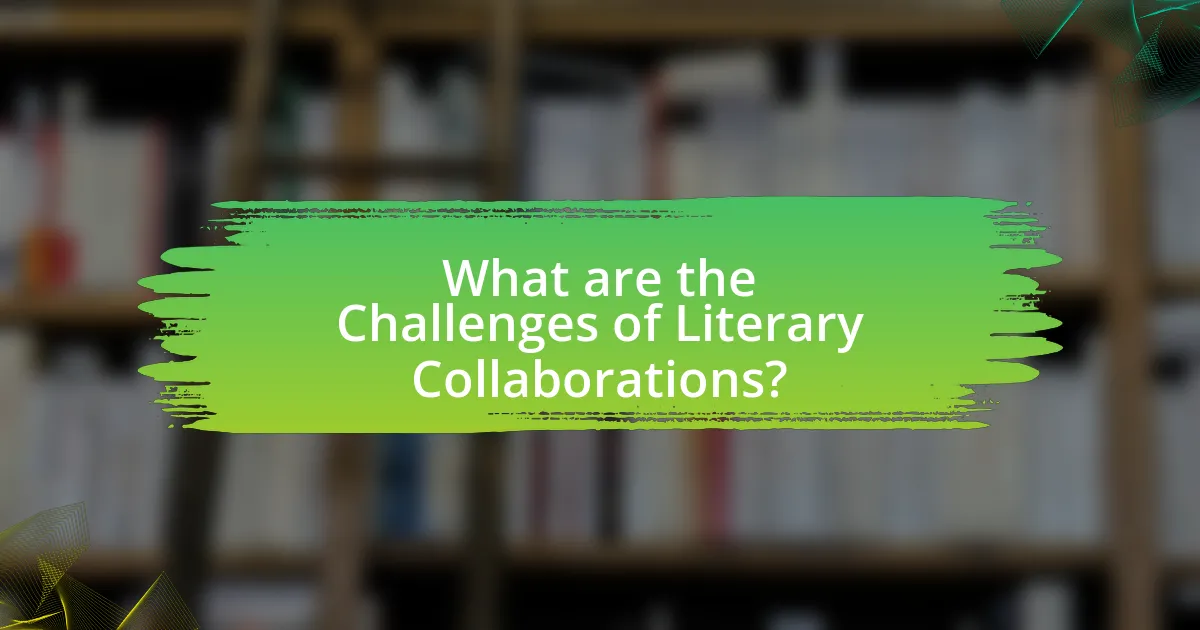
What are the Challenges of Literary Collaborations?
The challenges of literary collaborations include differing creative visions, communication issues, and unequal contributions among authors. Differing creative visions can lead to conflicts over the direction and style of the work, making it difficult to achieve a cohesive final product. Communication issues often arise when collaborators have different working styles or fail to establish clear expectations, which can result in misunderstandings and frustration. Additionally, unequal contributions can create tension if one author feels they are doing more work than the other, potentially leading to resentment and impacting the collaborative relationship. These challenges are well-documented in studies on collaborative writing, highlighting the importance of clear agreements and open dialogue to mitigate conflicts.
What common obstacles do authors face when collaborating?
Authors commonly face communication issues when collaborating, which can lead to misunderstandings and misaligned expectations. Effective collaboration requires clear dialogue about roles, deadlines, and creative direction; without this, projects can become disorganized. Additionally, differing writing styles and creative visions can create friction, as authors may struggle to reconcile their individual approaches to storytelling. Research indicates that 70% of collaborative projects fail due to these interpersonal dynamics, highlighting the importance of establishing a shared vision and open lines of communication from the outset.
How can differing writing styles create challenges in collaboration?
Differing writing styles can create challenges in collaboration by leading to miscommunication and inconsistency in the final product. When authors have distinct approaches to language, tone, and structure, it can result in a disjointed narrative that confuses readers. For instance, a study published in the Journal of Writing Research found that collaborative writing projects often suffer from a lack of coherence when contributors do not align their stylistic choices, which can detract from the overall quality of the work. This misalignment can also cause friction among collaborators, as differing expectations regarding style may lead to disagreements and hinder the creative process.
What are the potential conflicts that may arise between co-authors?
Potential conflicts that may arise between co-authors include disagreements over content, authorship credit, and decision-making authority. Disputes can occur when co-authors have differing visions for the project, leading to conflicts about the direction and tone of the work. Additionally, issues related to the distribution of credit can create tension, especially if one author feels their contributions are undervalued compared to others. Decision-making authority can also be a source of conflict, particularly if there is ambiguity regarding who has the final say on revisions or publication choices. These conflicts are common in collaborative writing and can impact the overall success of the project.
How can authors overcome challenges in literary collaborations?
Authors can overcome challenges in literary collaborations by establishing clear communication and defined roles from the outset. Effective communication ensures that all parties understand their responsibilities and expectations, which minimizes misunderstandings. Research indicates that projects with well-defined roles and open dialogue experience higher satisfaction rates among collaborators, as seen in studies on team dynamics in creative fields. Additionally, setting regular check-ins can help address any emerging issues promptly, fostering a collaborative environment that encourages creativity and problem-solving.
What strategies can be employed to ensure successful collaboration?
Successful collaboration can be ensured by establishing clear communication channels among all participants. Effective communication fosters understanding, aligns goals, and minimizes misunderstandings, which are critical in collaborative efforts. Research indicates that teams with open communication are 25% more productive, as they can share ideas and feedback more efficiently. Additionally, defining roles and responsibilities upfront helps to clarify expectations and accountability, further enhancing collaboration. Implementing regular check-ins and feedback sessions can also facilitate ongoing dialogue, allowing for adjustments and improvements throughout the collaborative process.
How important is communication in collaborative writing?
Communication is crucial in collaborative writing as it ensures clarity, alignment, and cohesion among team members. Effective communication facilitates the sharing of ideas, feedback, and revisions, which are essential for producing a unified piece of work. Research indicates that projects with strong communication practices are 25% more likely to succeed, highlighting the direct correlation between communication and project outcomes. In collaborative writing, clear dialogue helps prevent misunderstandings and fosters a productive environment, ultimately leading to a more polished final product.
What are the Best Practices for Successful Literary Collaborations?
Successful literary collaborations require clear communication, defined roles, and mutual respect among authors. Establishing open lines of communication ensures that all parties can express ideas and concerns, fostering a collaborative environment. Defining roles helps to clarify responsibilities, preventing overlap and confusion, which can lead to conflicts. Mutual respect is essential for valuing each author’s contributions, promoting a positive working relationship. Research indicates that collaborations with these practices often yield higher quality work and greater satisfaction among participants, as seen in successful partnerships like that of Neil Gaiman and Terry Pratchett in “Good Omens.”
How can authors establish clear roles and responsibilities?
Authors can establish clear roles and responsibilities by creating a detailed collaboration agreement that outlines each participant’s contributions, expectations, and deadlines. This agreement serves as a foundational document that clarifies who is responsible for specific tasks, such as writing, editing, and marketing. By explicitly defining these roles, authors can minimize misunderstandings and ensure that all parties are aligned on their objectives. Research indicates that structured agreements in collaborative projects lead to higher satisfaction and productivity among team members, as seen in studies on teamwork dynamics in creative industries.
What tools and resources can facilitate effective collaboration?
Effective collaboration can be facilitated by tools such as Google Docs, Slack, and Trello. Google Docs allows multiple authors to edit documents in real-time, enhancing immediate feedback and idea sharing. Slack provides a platform for instant communication, enabling authors to discuss ideas and share resources quickly. Trello offers a visual project management system that helps authors organize tasks and track progress collaboratively. These tools are widely used in literary collaborations, as they streamline communication and project management, ultimately leading to more productive partnerships.
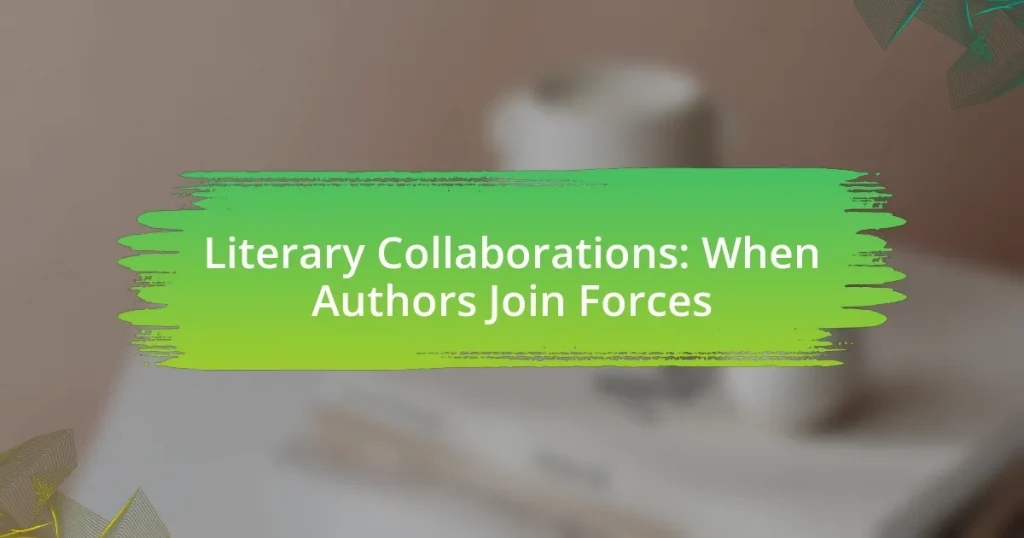

![The Legacy of [Author’s Name]: How Their Work Influences New Writers](https://hotkeyblog.com/wp-content/uploads/Featured-image-The-Legacy-of-Authors-Name-How-Their-Work-Influences-New-Writers-150x150.webp)
